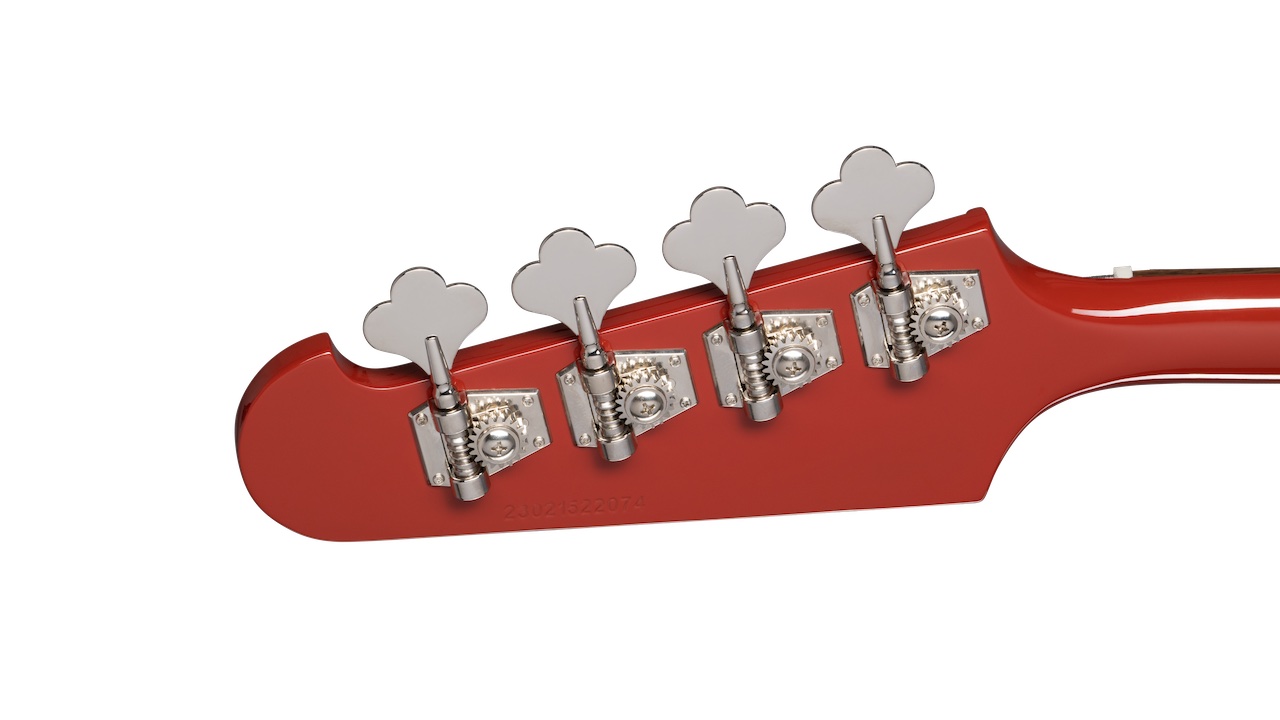
Bass players from all genres have been known to deploy a Thunderbird, most obviously because of its mids-heavy tone, but also because it looks so cool.
The Gibson Thunderbird was originally introduced back in 1963 and for many years competed favourably against the products emanating from the Fender stable. The reverse body made it a hit with rock players the world over, John Entwistle being one notable user, and to this day it remains a favourite with bassists who enjoy the look, retro styling and thick tone of the original models, which are now highly prized collectors items sporting expensive price tags.
Luckily, the new Thunderbird '64 from Gibson's more affordable offshoot Epiphone combines original T-bird–specific features yet sits at less than half the price of a fully-fledged Gibson.
Launched in honour of the 60th anniversary of the original Thunderbird, let's see if this plucky upstart can give the big boys a run for their money.



Build Quality
So what does all this vintage-style loveliness entail? Well, it starts with mahogany, and plenty of it. In traditional Thunderbird fashion, the body features a nine-ply mahogany and walnut neck-through build with mahogany wings.
Interestingly, the Thunderbird was Gibson’s first true long-scale bass, and long certainly is the operative word. These basses look huge and feel pretty monstrous to wear – compare an overall P-Bass length of 45.5 inches to the humungous 50 inches of the Thunderbird.
Weight-wise, you might be surprised to learn that the T-bird’s excessive size isn’t matched by a corresponding weight penalty, but that in itself brings problems; sitting down is fine while the bass sits across your leg, but stand up and the unbalanced headstock weight pulls the neck straight down to the floor.
This means the bass has to be played either with your under forearm resting across the top of the bass as you pluck by the neck, or you have to support the bass with your fretting hand as you play it.
It’s still a manageable load to bear for the duration of a gig, and anyway, it just wouldn't feel right to play this bass slung low on the strap Nikki Sixx-fashion if it didn't have a bit of neck dive.


The nine-ply Mahogany/Walnut neck feels nice and chunky – there's certainly plenty to hold on to here, but it is not so chunky as to hamper your playing technique. The Indian Laurel board is home to 20 medium-sized frets.
The funky scratchplate has the neat American Indian-style eagle emblem. Note also, the two strap buttons on the heel and the lower bout – sadly both were unable to prevent the headstock from trying to kiss the floor.
Along with the cool Ember Red finish and matching headstock, it was the hardware spec that caught our eye when this bass was first announced. Top billing goes to the set of ProBucker 760 humbuckers. They’re wired to individual volume controls and a master tone, with the output jack socket sitting below.
Strings are firmly anchored with a tune-o-matic style bridge and ‘tail claw’ (all nickel-plated), with the latter a superbly minimalist but perfectly functional anchor piece. Open-gear, clover tuners hold it in tune at the other end.


Sounds and Playability
Unplugged, the Thunderbird ’64 sounds bright and ballsy. It's loud with plenty of sustain and, thanks to the high standard of setup, the medium action offers great playability. That monstrous neck really encourages you to get stuck in and, before it's even seen an amplifier, all signs point towards this bass being a whole lot of fun to play.
Plug it in and there’s a comfortingly retro hollowness to the sound, brought up-to-date by the ProBucker humbuckers. Unsurprisingly, these pickups come into their own in a heavy rock setting. There’s real bite here, and with plenty of sustain too. The bridge pickup is bright and twangy without being too thin, while the neck pickup is more full and bassy without sounding dull or flabby.
The Thunderbird '64 can sound funky too, but, as a full on rock bass whacked with the heaviest plectrum you can find is when it’s in its element – hence its popularity with the genre.
Upper-fret access is, as you might have guessed, a little restricted, thanks to the protruding lower horn, even though the neck itself is lovely to play.
Conclusion
With the styling of its body and headstock, the Thunderbird ’64 makes no secret of its rock inclinations, but it’s nonetheless not so outlandish as to put off players who have never so much as owned a leather jacket. And the fact that it stands out in terms of playability, when that visual vibe is so distinctive, says a lot about the quality of Epiphone’s Chinese-built instruments.
I must admit, the whole time I was playing this bass, I was constantly petrified that someone or something would bump into the over-projecting headstock causing it to snap behind the nut. All mahogany-built Gibsons are infamous for this particular party trick.
To our relief, the bass is highly playable. Sure, it comes with a ‘big’ feel: a kind of solid, chunky, presence, but it also has that vintage-vibe that perfectly illustrates why old instruments are still so loved.
It's priced some way below the $1,000 mark, which considering what you get for the money, is pretty good value. It may not be quite as versatile in terms of tone as modern rock players might want, but what it lacks in versatility, it makes up for in pure Thunderbird feistiness.
Specs
- Price: $849 / £849 (inc gigbag)
- Made in: China
- Body: 9-ply mahogany/walnut, neck-through
- Neck: 9-ply mahogany/walnut, 34” scale
- Nut: Graph Tech
- Fingerboard: Indian laurel, 20 frets
- Pickups: 2x ProBucker 760 Bass Humbucker
- Controls: 2x Master Volume, Master Tone
- Hardware: Open-gear tuners, Vintage 'Historic Tune-O-Matic' bridge
- Weight: 8.8 lbs / 3.9 kg
- Available finishes: Ember Red, Silver Mist, Inverness Green.
- Contact: Epiphone







